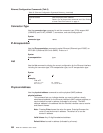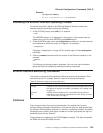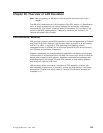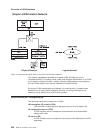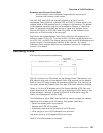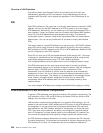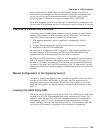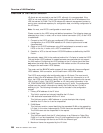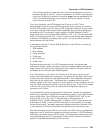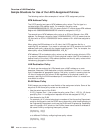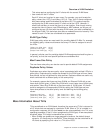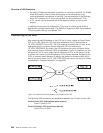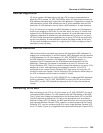
End stations obtain their Network Prefix from the switch and form their own
addresses by appending an ESI and selector. These addresses must then be
registered with the switch, which rejects the registration if the ATM address is not
unique.
ESI
Each ATM interface on the router has a universally administered, or burned-in, MAC
address. You can use the MAC address as an ESI for some or all of the router’s
ATM addresses. Alternatively, you can define up to 64 locally administered ESIs on
each interface. If every end system uses its universally administered MAC address
as its ESI, then ATM addresses are guaranteed to be unique. This eases the
configuration burden. However, using locally administered ESIs can ease problem
determination. You can use any combination of universal or locally administered
ESIs.
One way to obtain a unique ATM address is to use a burned-in IEEE MAC address
as the ESI and to locally choose a unique selector. By default, the router uses the
MAC address of the ATM interface as the ESI in its ATM addresses. Additional ESIs
can be configured on each ATM interface.
Each ESI can have up to 255 associated selectors (0x00 through 0xff). The range
of selectors is partitioned into two subranges, a configured selector range and an
automatically assigned selector range. The ATM interface parameter
max-configured-selector gives the upper bound on the configured selector range.
The ATM components on the router have various ways of choosing a selector.
Some components require you to explicitly configure a selector from the configured
selector range. LES/BUSs are an example of such a component. Other
components, such as Classical IP clients, allow the selector to be automatically
assigned at run-time. You do not have to choose the selector because the router
does this when it activates. This selector is not guaranteed to be consistent across
router restarts. Automatic selector assignment is useful only for those ATM
components whose ATM address does not have to be already known by other
network devices.
You must configure ATM before you configure emulated LANs, bridging or routing.
ATM Addresses of LAN Emulation Components
In general, ATM addresses must be unique among LAN emulation components. The
only exception is that a LES and BUS serving the same ELAN can share an ATM
address, as is the case on the router.
LAN emulation components are configured for a particular ATM interface. You can
decide to use the burned-in MAC address as the ESI portion of the ATM address of
the component or you can select one of the locally-administered ESIs that have
been defined for the ATM interface. Multiple LE components can share the same
ESI if they have unique selectors. By default, the configuration interface assigns
each LE component a unique selector value for the configured ESI; however, you
can override this assignment and explicitly configure a particular selector value.
An ATM interface parameter determines the number of selectors per ESI reserved
for explicit assignment. The remainder are available for dynamic assignment by the
ATM interface at run-time. LE components use only the selectors reserved for
Overview of LAN Emulation
258
MRS V3.2 Software User’s Guide





